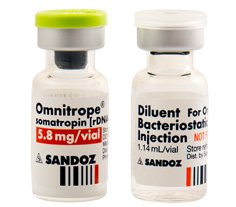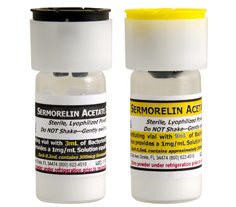| Producing Gland |
Hormone |
Target |
Primary Functions |
| Adipose Tissue |
Adiponectin |
Adiponectin receptors |
Modulates lipid and glucose metabolism, fatty acid oxidation |
| Leptin |
Hypothalamus |
Decrease appetite, regulate energy, support metabolic function |
| Anterior Pituitary Gland
Also the Skin and Hypothalamus |
Adrenocorticotropic Hormone (ACTH – corticotropin) |
Adrenal glands |
Corticosteroid synthesis, cortisol production in adrenal glands |
| Follicle Stimulating Hormone (FSH) |
Testes, ovaries |
Males: stimulates testosterone production and spermatogenesis, Females: promotes development of ova and follicles before ovulation |
| Growth Hormone (somatotropin) |
Bones, brain, cartilage, cells, fat, hair, heart, liver, muscle, skin |
Stimulates insulin growth factor 1 release, cellular reproduction, brain functions, immunity, metabolism, libido, and more |
| Lipotropin |
Fat reserves |
Stimulates lipolysis, melanin, and steroidogenesis |
| Luteinizing Hormone |
Testes, ovaries |
Males: stimulates testosterone release, Females: promotes ovulation, estrogen, and progesterone production |
| Melanocyte Stimulating Hormone |
Melanocytes (pigment cells) |
Produces color pigmentation (melanin) in the hair, skin, & eyes |
| Prolactin |
Brain, breasts |
Sexual behavior and gratification, milk production |
| Thyroid Stimulating Hormone (TSH-thyrotropin) |
Thyroid gland |
Stimulates the secretion of thyroxine and triiodothyronine |
| Bones |
Osteocalcin (BGLAP) |
Brain, muscle, pancreas, testes |
Memory formation, energy, muscle function, testosterone synthesis |
| Cerebral Cortex |
Cortistatin |
Cortex, amygdala, hippocampus |
Reduces locomotor activity, depresses neuronal activity, induces slow-wave sleep |
| Duodenum
Also Jejunum Mucosa |
Cholecystokinin (CCK) |
Pancreas, liver, gallbladder |
Decreases appetite, releases digestion enzymes and bile |
| Gastric Inhibitory Polypeptide (GIP) |
Pancreas |
Induces secretion of insulin |
| Secretin |
Liver and stomach |
Inhibits stomach secretions, increases bile production |
| Epithelium (goblet cells in colon) |
Guanylin |
Guanylin receptor |
Regulates water and electrolyte transport in renal and intestinal epithelia |
| Gastrointestinal Tract and Central Nervous System |
Galanin |
Hypothalamus, brainstem, cortex, pancreas, stomach, colon, intestines |
Inhibits insulin, somatostatin, and dopamine, helps regulate growth hormone release, increases prolactin, contracts gastrointestinal smooth muscle |
| Heart |
Atrial-Natriuretic Peptide (atriopeptin) |
Blood cellular receptors |
Vasodilation |
| Brain Natriuretic Peptide |
Atrial receptors |
Dilator |
| Hypothalamus
Also pancreas and gastrointestinal system |
Corticotropin-Releasing Hormone |
Anterior pituitary gland |
Influences cortisol and ACTH release |
| Gonadotropin-Releasing Hormone |
Anterior pituitary gland |
Stimulates LH and FSH secretion |
| Growth Hormone-Releasing Hormone |
Anterior pituitary gland |
Stimulates growth hormone secretion |
| Orexin |
Neurotransmitters |
Increases appetite and energy expenditure, wakefulness |
| Prolactin Releasing Hormone |
Anterior pituitary gland |
Prolactin secretion |
| Somatostatin |
Anterior pituitary gland, gastrointestinal system, pancreas |
Inhibitor of growth hormone, thyroid stimulating hormone, insulin, cholecystokinin, glucagon release |
| Thyrotropin-Releasing Hormone |
Anterior pituitary gland |
Regulates activity of thyroid gland and thyroid stimulating hormone |
| Ileum |
Glucagon-Like Peptide-1 |
Pancreatic beta cells |
Increases synthesis and release of insulin |
| Kidney
Also Liver, Striated Muscle |
Enkephalin |
Opioid receptors |
Regulates pain |
| Erythropoietin |
Bone marrow |
Stimulates red blood cell production |
| Renin |
Enzymatic activity |
Blood pressure regulation |
| Thrombopoietin |
Megakaryocytes |
Produces blood platelets |
| Liver |
Angiotensinogen and Angiotensin |
Adrenal cortex, most tissues |
Aldosterone release, salt retention, vasoconstriction, thirst |
| Hepcidin |
Gut enterocytes and plasma membrane of macrophages |
Inhibits cellular iron export and absorption |
| Insulin Growth Factor |
Skeletal, muscle, cartilage, cells |
Mediates growth hormone effects and cell reproduction |
| Ovaries, Testes, Fetus |
Inhibin |
Ovaries, testes |
Inhibits FSH secretion |
| Pancreas |
Amylin |
Kidney, bone |
Reduces food intake, inhibits digestive secretions, bone metabolism |
| Glucagon |
Liver |
Increases blood glucose levels, liver glycogenolysis and gluconeogenesis |
| Insulin |
Fat tissue, muscle |
Regulates glucose levels |
| Pancreatic Polypeptide |
Pancreas, brain |
Regulates gastrointestinal and pancreatic secretions |
| Vasoactive Intestinal Peptide |
Heart, stomach, gallbladder, trachea |
Glycogenolysis, heart contractility, lowers blood pressure, reduces inflammation, vasodilation |
| Parathyroid |
Parathyroid Hormone |
Bone cells, kidney |
Increases blood calcium and reabsorption in kidney, activates vitamin D |
| Placenta |
Human Chorionic Gonadotropin |
Ovary, testes |
Secretion of progesterone by corpus luteum at onset of pregnancy, repels immune cells to protect fetus, helps increase testosterone production |
| Human Placental Lactogen |
Only present during pregnancy |
Increases carbohydrate intolerance, insulin resistance, insulin and IGF-1 production to facilitate energy supply of the fetus |
| Posterior Pituitary Gland |
Antidiuretic Hormone (vasopressin, arginine vasopressin, ADH) |
Blood vessels, kidneys, anterior pituitary |
ACTH secretion, blood pressure maintenance thru kidney water retention and blood vessel constriction |
| Oxytocin |
Breast milk ducts, uterus |
Uterine constriction during labor, milk production |
| Renal Tissue |
Uroguanylin |
Renal epithelia |
Regulates renal salt and water transport |
| Small Intestine |
Motilin |
Pancreas, gallbladder |
Gastric activity stimulator |
| Stomach
Also Duodenum |
Ghrelin |
Hypothalamus |
Appetite stimulation, growth hormone secretion, energy use |
| Gastrin |
Stomach |
Stomach acid secretion |
| Testes |
Anti-Mullerian Hormone |
Anterior pituitary gland |
Inhibits TRH and prolactin release |
| Thyroid |
Calcitonin |
Bones |
Regulation of calcium and inhibitor of bone osteoclast breakdown |
| Uterus, Placenta, Corpus Luteum, Mammary Glands, Prostate Gland |
Relaxin |
Cervix, reproductive system organs |
Increase blood flow to placenta, softens and widens cervix for childbirth, relaxes pelvic ligaments, Males: semen movement |
| Vascular Endothelium |
Endothelin |
Vascular smooth muscle, heart |
Medium-sized vessel smooth muscle contraction |
| Multiple |
Pituitary Adenylate Cyclase-Activating Peptide |
Vasoactive intestinal peptide receptors |
Neurotransmitter, neuromodulator, induces hypophysis activity |
 This comprehensive guide to the 4 main types of hormones in the human body and their functions will show you where the hormones are produced, what they impact, and how they benefit the body.
Looking at the role of different hormones in the human body , we see how some impact brain functions, others support bone and muscle growth, some strengthen immunity, and others even promote a healthy libido. From digestion to breathing, blood flow to memory, the following 4 main types of hormones are always at work:
This comprehensive guide to the 4 main types of hormones in the human body and their functions will show you where the hormones are produced, what they impact, and how they benefit the body.
Looking at the role of different hormones in the human body , we see how some impact brain functions, others support bone and muscle growth, some strengthen immunity, and others even promote a healthy libido. From digestion to breathing, blood flow to memory, the following 4 main types of hormones are always at work:




















